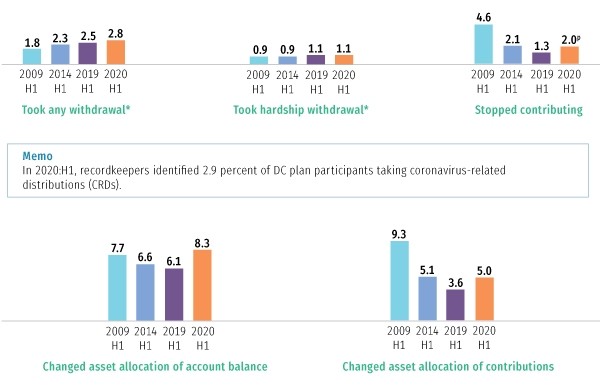Retirement Savers Maintain Commitment Despite COVID-19 Economic Downturn
Recordkeeper data covering first half of 2020 show only slight increase in withdrawal activity
Washington, DC; August 19, 2020—Americans continued to save for retirement through defined contribution (DC) plans during the first half of this year despite economic stresses brought about by the COVID-19 pandemic, according to ICI’s “Defined Contribution Plan Participants’ Activities, First Half 2020.” The study tracks contributions, withdrawals, and other activity in 401(k) and other DC retirement plans, based on DC plan recordkeeper data covering more than 30 million participant accounts in employer-based DC plans at the end of June 2020. This edition of the study also tracks coronavirus-related distributions among plan participants to provide insight into financial activity related to the pandemic.
The latest recordkeeper data indicate that plan participants remained committed to saving and investing: preliminary estimates indicate that only 2.0 percent of DC plan participants stopped contributing to their plans in the first half of 2020, a typical rate across the majority of the 12 years ICI has tracked these data. That compares with 1.3 percent in the first half of 2019, and 4.6 percent in the first half of 2009 (another time of financial stress).
“These data reflect the long-term mindset of retirement savers,” said Sarah Holden, ICI senior director of retirement and investor research. “We see a slight increase in withdrawal activity following the onset of economic volatility and hardship, but the increase is much smaller than you might expect, given the severity of the COVID-19 economic downturn. These assets represent a pot of money that savers have earmarked for retirement and they have consistently demonstrated that they generally stay the course to reach that financial goal, even during challenging economic situations.”
Defined Contribution Plan Participants' Activities
Summary of recordkeeper data, percentage of participants

* These withdrawals do not include coronavirus-related distributions (CRDs) identified by the recordkeepers.
p Data are preliminary based on a partial sample of DC plans in the survey.
Note: The samples include nearly 24 million DC plan participants in 2009 and 2014 and more than 30 million in 2019 and 2020. Activity reported covers the first half of each year indicated.
Source: ICI Survey of DC Plan Recordkeepers
Other findings include:
- Most DC plan participants stayed the course in their asset allocations despite stock market volatility at the end of the first quarter of 2020. In the first half of 2020, 8.3 percent of DC plan participants changed the asset allocation of their account balances, and 5.0 percent changed the asset allocation of their contributions. These levels of activity were slightly higher than the activity observed in the same time frame a year earlier.
- Withdrawal activity for DC plans remained low in the first half of 2020, although it was slightly higher than the activity observed in the first half of 2019. In the first half of 2020, 2.8 percent of DC plan participants took withdrawals, compared with 2.5 percent in the first half of 2019. Levels of hardship withdrawal activity also were low, with only 1.1 percent of DC plan participants taking hardship withdrawals during the first half of 2020, the same share of participants as in the first half of 2019.
- The recordkeepers surveyed identified 2.9 percent of DC plan participants as taking coronavirus-related distributions (CRDs) during the first half of 2020. The Coronavirus Aid, Relief, and Economic Security Act (CARES Act), enacted March 27, 2020, provides penalty relief and increased flexibility in retirement plan withdrawals for individuals affected by COVID-19.
- DC plan participants’ loan activity edged down in the second quarter of 2020. At the end of June 2020, 15.6 percent of DC plan participants had loans outstanding, compared with 16.3 percent at the end of March 2020 and 16.1 percent at year-end 2019. This may reflect the use of CRDs instead of loans. CRDs, like loans, can be repaid into a retirement account; however, unlike loans, they may have current tax implications.
ICI has been tracking DC plan participant activity through recordkeeper surveys since 2008. This update provides results from ICI’s survey of a cross section of recordkeeping firms representing a broad range of DC plans. Please visit ICI’s 401(k) Resource Center for more information.
